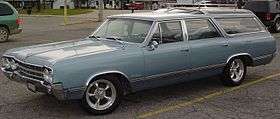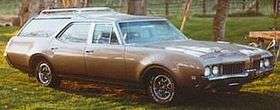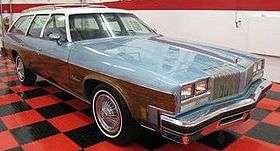Oldsmobile Vista Cruiser
| Oldsmobile Vista Cruiser | |
|---|---|
.jpg) 1966 Vista Cruiser | |
| Overview | |
| Manufacturer | Oldsmobile (General Motors) |
| Model years | 1964–1977 |
| Assembly | Lansing Car Assembly, Lansing, Michigan |
| Body and chassis | |
| Class | Mid-size |
| Body style | Station Wagon |
| Layout | FR layout |
| Platform | A-body |
| Related | Buick Sport Wagon |
| Chronology | |
| Successor | Oldsmobile Cutlass Cruiser |
The Vista Cruiser is a station wagon that was manufactured and marketed by Oldsmobile from 1964 to 1977 over three generations.
The first and second generation Vista Cruisers are noted for their fixed-glass, roof-mounted skylights over the second-row seating with sun visors for the second row passengers, a raised roof behind the skylight and lateral glass panels over the rear cargo area along the raised roof — and three rows of forward-facing passenger seating. Sharing its bodystyle with the Buick Sport Wagon, the Vista Cruiser was introduced on February 4, 1964, as a 1964 model, based on the Oldsmobile Cutlass/F-85 model. Prior to the 1973 model year the Vista Cruiser utilized a wheelbase which was 5 inches (127 mm) longer than that of the Cutlass/F-85 sedan.
Subsequent Oldsmobile mid-size wagons featured a skylight as did the 1991–92 full-size Oldsmobile Custom Cruiser wagon and the 1991–96 Buick Roadmaster wagon.
Reminiscent of earlier models, the third generation Vista Cruiser (1973–1977) featured optional rear-facing third row seating, while incorporating a single fixed, flat venting skylight over the second row seating.
GM's 1971–76 full-size clamshell wagons, including the Oldsmobile Custom Cruiser, incorporated an optional forward-facing third row and a slightly elevated roof over the cargo area, though no skylight.
1964–1967
| First generation | |
|---|---|
 1965 Vista Cruiser | |
| Overview | |
| Model years | 1964–1967 |
| Body and chassis | |
| Related |
Buick Special Buick Sport Wagon Chevrolet Chevelle Oldsmobile Cutlass Pontiac Grand Prix Pontiac Tempest |
| Powertrain | |
| Engine | 330 in3 (5,408 cc; 5.408 L) Rocket V8 |
| Transmission |
2-speed automatic 3-speed automatic 4-speed manual 3-speed manual |
| Dimensions | |
| Wheelbase | 120 in (3,048 mm) |
The first-generation Vista Cruiser offered a split skylight over the second row of seats.
In 1964, the Vista Cruiser was one of three station wagons offered by Oldsmobile, the others being the F-85 built on the same wheelbase as other F-85/Cutlass intermediates and the full-sized Dynamic 88 Fiesta.
.jpg)
From 1965 to 1970, the Vista Cruiser became the division's largest wagon as Olds did not offer a station wagon in the full-sized 88 series and the intermediate F-85/Cutlass were also offered during each of those years on the shorter wheelbase.
Engine offerings in the Vista Cruiser paralleled other Olds intermediates with a 330-cubic-inch (5,408 cc) V8 offered from 1964 to 1967 with ratings from 210 to 320 horsepower (160 to 240 kW) depending on year and carburetion.
Transmission offerings included the two-speed Jetaway automatic transmission and two rarely equipped manual transmissions including a three-speed column shift and a four-speed floor shift.
1968–1972
| Second generation | |
|---|---|
 1969 Vista Cruiser | |
| Overview | |
| Model years | 1968–1972 |
| Body and chassis | |
| Related |
Chevrolet Monte Carlo Chevrolet El Camino Pontiac Grand Prix Pontiac Tempest Buick Special Buick Sport Wagon Oldsmobile Cutlass GMC Sprint |
| Powertrain | |
| Engine |
350 cu in (5.7 L) Rocket V8 400 cu in (6.6 L) Rocket V8 455 cu in (7.5 L) Rocket V8 |
| Transmission |
2-speed automatic 3-speed automatic 4-speed manual 3-speed manual |
| Dimensions | |
| Wheelbase | 121 in (3,073 mm) |
| Length | 218.2 in (5,542 mm) |
| Width | 77.2 in (1,961 mm) |
| Height | 58.6 in (1,488 mm) |
| Curb weight | 4,064 lb (1,843 kg) |
A major restyling of the GM A-body car line for 1968 replaced the split skylight with a one-piece skylight, and stretched the wheelbase from 120 to 121 in (3,048 to 3,073 mm).
From 1968 to 1972, a 350-cubic-inch (5,700 cc; 5.7 L) V8 became standard with a larger 400-cubic-inch (6,600 cc; 6.6 L) V8 from the 442 muscle car optional in 1968-69 and a 455-cubic-inch (7,460 cc; 7.46 L) V8 available from 1970 to 1972.
Transmission offerings through the years included one of two automatics—the two-speed Jetaway (1968) or three-speed Turbo Hydramatic (1968–72), or very rarely, a standard three-speed manual with column shift or optional four-speed manual with floor-mounted Hurst shifter.
In 1969, the "Dual-Action" tailgate was first offered, as standard equipment on the three-row models and as optional equipment on the two-row models.
In 1970, a redesign reshaped much of the exterior sheet metal, making the edges and curves sharper. Although it closely resembled the 1968-69 models, and is essentially considered to be a second-generation car, many of the body parts were no longer interchangeable with the earlier second-generation cars. The dashboard was also completely redesigned. (The GM Skywagon Club recognizes the 1970-72 models as "Generation 2a")
For 1971, Olds brought back the full-sized Custom Cruiser wagon on the 98 chassis utilizing GM's disappearing clamshell tailgate, but the glass-roofed Vista Cruiser continued until 1972.
A small number of 1972 Vista Cruisers were modified by Hurst Performance, then based in Warminster Township, Pennsylvania for support car duties at the 1972 Indianapolis 500 and equipped with 455-cubic-inch (7,460 cc; 7.46 L) Rocket V8s along with the official pace car, a 1972 Hurst/Olds, also powered by a 455 V8. Two are known to survive as of 2012, a press car and a medical director's car. As of 2012, the medical director's car is owned by a relative of Ray Harroun, the winner of the first Indianapolis 500 in 1911.
1973–1977
| Third generation | |
|---|---|
 1976-1977 Oldsmobile Vista Cruiser | |
| Overview | |
| Also called | Oldsmobile Cutlass Supreme station wagon |
| Model years | 1973–1977 |
| Body and chassis | |
| Platform | GM A-body |
| Related |
Buick Century Chevrolet Chevelle Chevrolet Malibu Oldsmobile Cutlass Pontiac LeMans |
| Powertrain | |
| Engine |
350 cu in (5.7 L) Rocket V8 403 cu in (6.6 L) Rocket V8 (1977) 455-cubic-inch (7.5 L) Rocket V8 (1973–76) |
| Transmission | 3-speed automatic |
| Dimensions | |
| Wheelbase | 116 in (2,946 mm) |
For 1973, the GM A-body intermediate platform was completely redesigned. Notably, the separate wheelbase used by the Vista Cruiser and Buick Sport Wagon was eliminated; all A-body wagons were now built on the 116-inch sedan wheelbase. While its Buick counterpart was discontinued, the Vista Cruiser was redesigned as a woodgrained version of the new Cutlass Supreme station wagon. Despite the shortened wheelbase, third-row seating made its return, although the seat now faced rearward.
"Colonnade" styling and frameless door glass increased side window area, which came at the expense of the model's distinctive skylights. In place of the skylights came an optional pop-up sunroof over the front seats.
Engine offerings during this period included a standard 350 cubic-inch Rocket V8 or optional 455 cubic-inch Rocket V8 through 1976. For 1977, the 455 was replaced by a 403 cubic-inch Rocket V8. The three-speed Turbo Hydra-matic transmission, power steering and power front disc brakes were standard equipment on Vista Cruisers during the 1973-77 period.
In popular culture
At the beginning of National Lampoon's Vacation the car that gets crushed is a 1971 Oldsmobile Vista Cruiser.
A first-generation Vista Cruiser was used as the mother's car in the 1992 film Radio Flyer. It bore a reproduction 1965 Pennsylvania license plate.
A second-generation Vista Cruiser was prominently featured in the 2002 English film, Once Upon a Time in the Midlands.
A first-generation Vista Cruiser also featured prominently as Oliver and Emily's car in the 2005 film A Lot Like Love.
A first-generation Vista Cruiser appears in the 2011 movie Judy Moody and the Not Bummer Summer.
A 1969 Vista Cruiser was Eric Forman's car on That '70s Show. It was sold to Wilmer Valderrama, the actor who played Fez, for US$500 when the show ended in 2006.[1]
A second generation 1972 Vista Cruiser is driven by both Walter Bishop and Peter Bishop in the TV series Fringe.[2]
Matchbox released a 1971 Vista Cruiser in their 2009 1-100 diecast vehicle range.
References
External links
| ||||||||||||||||||||||||
| Oldsmobile road car timeline, Post WW2–1970s — next » | ||||||||||||||||||||||||||||||||||
|---|---|---|---|---|---|---|---|---|---|---|---|---|---|---|---|---|---|---|---|---|---|---|---|---|---|---|---|---|---|---|---|---|---|---|
| Type | 1940s | 1950s | 1960s | 1970s | ||||||||||||||||||||||||||||||
| 6 | 7 | 8 | 9 | 0 | 1 | 2 | 3 | 4 | 5 | 6 | 7 | 8 | 9 | 0 | 1 | 2 | 3 | 4 | 5 | 6 | 7 | 8 | 9 | 0 | 1 | 2 | 3 | 4 | 5 | 6 | 7 | 8 | 9 | |
| Subcompact | Starfire | |||||||||||||||||||||||||||||||||
| Compact | F-85 | |||||||||||||||||||||||||||||||||
| Cutlass | Omega | |||||||||||||||||||||||||||||||||
| Mid-size | F-85 | F-85 | ||||||||||||||||||||||||||||||||
| Cutlass | Cutlass | Cutlass | Cutlass | |||||||||||||||||||||||||||||||
| Mid-size station wagon | Vista Cruiser | Vista Cruiser | Vista Cruiser | Cutlass Cruiser | ||||||||||||||||||||||||||||||
| Full-size | 66/68 | |||||||||||||||||||||||||||||||||
| 76/78 | 76 | |||||||||||||||||||||||||||||||||
| 88 | 88 | 88 | 88 | 88 | 88 | 88 | 88 | |||||||||||||||||||||||||||
| 98 | 98 | Ninety- |
Ninety- |
Ninety- |
Ninety- |
Ninety- |
Ninety- |
Ninety- | ||||||||||||||||||||||||||
| Full-size station wagon | 76 | 88 Fiesta | 88 Fiesta | 88 Fiesta | Custom Cruiser | Custom Cruiser | ||||||||||||||||||||||||||||
| 88 | ||||||||||||||||||||||||||||||||||
| Personal luxury | Toronado | Toronado | Toronado | |||||||||||||||||||||||||||||||